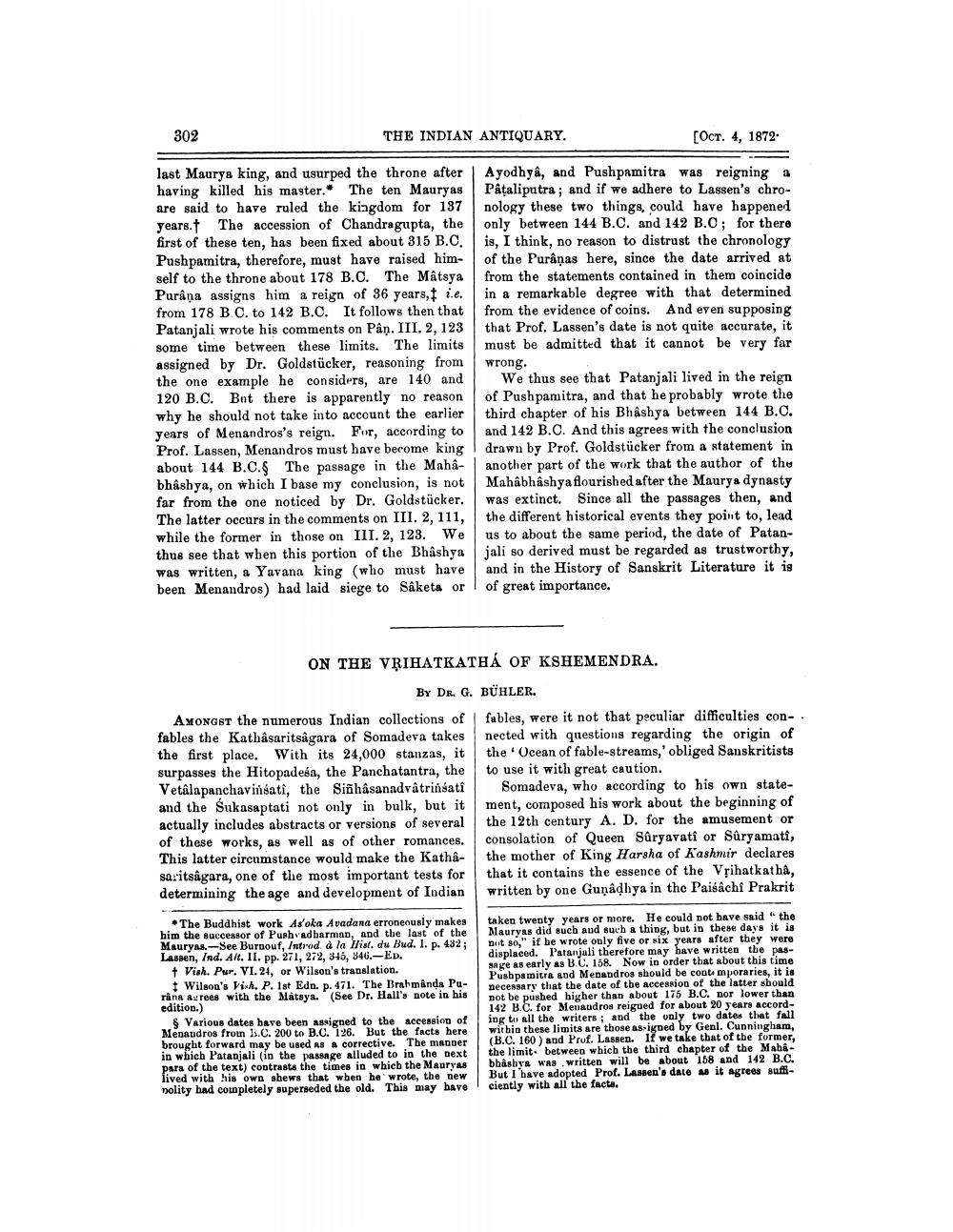________________
302
THE INDIAN ANTIQUARY.
last Maurya king, and usurped the throne after having killed his master. The ten Mauryas are said to have ruled the kingdom for 187 years. The accession of Chandragupta, the first of these ten, has been fixed about 315 B.C. Pushpamitra, therefore, must have raised himself to the throne about 178 B.C. The Mâtsya Purâna assigns him a reign of 36 years, i.e. from 178 B.C. to 142 B.C. It follows then that Patanjali wrote his comments on Pân. III. 2, 123 some time between these limits. The limits assigned by Dr. Goldstücker, reasoning from the one example he considers, are 140 and 120 B.C. But there is apparently no reason why he should not take into account the earlier years of Menandros's reign. For, according to Prof. Lassen, Menandros must have become king about 144 B.C.§ The passage in the Mahâbhâshya, on which I base my conclusion, is not far from the one noticed by Dr. Goldstücker. The latter occurs in the comments on III. 2, 111, while the former in those on III. 2, 123. We thus see that when this portion of the Bhâshya was written, a Yavana king (who must have been Menandros) had laid siege to Sâketa or
ON THE VṚIHATKATHA OF KSHEMENDRA. BY DR. G. BÜHLER.
AMONGST the numerous Indian collections of fables the Kathâsaritsagara of Somadeva takes the first place. With its 24,000 stanzas, it surpasses the Hitopadesa, the Panchatantra, the Vetâlapanchavinsati, the Siñhâsanadvâtrinsati and the Sukasaptati not only in bulk, but it actually includes abstracts or versions of several of these works, as well as of other romances. This latter circumstance would make the Kathâsaritsagara, one of the most important tests for determining the age and development of Indian
The Buddhist work As'oka Avadana erroneously makes him the successor of Pushyadharman, and the last of the Mauryas.-See Burnouf, Introd à la Hist. du Bud. I. p. 432; Lassen, Ind. Alt. II. pp. 271, 272, 345, 346.-ED.
+ Vish. Pur. VI. 24, or Wilson's translation.
Wilson's Vish. P. 1st Edn. p. 471. The Brahmânda Purâna aurees with the Matsya. (See Dr. Hall's note in his edition.)
[OCT. 4, 1872.
Ayodhya, and Pushpamitra was reigning a Pâțaliputra; and if we adhere to Lassen's chronology these two things, could have happened only between 144 B.C. and 142 B.C; for there is, I think, no reason to distrust the chronology of the Purânas here, since the date arrived at from the statements contained in them coincide in a remarkable degree with that determined from the evidence of coins. And even supposing that Prof. Lassen's date is not quite accurate, it must be admitted that it cannot be very far wrong.
We thus see that Patanjali lived in the reign of Pushpamitra, and that he probably wrote the third chapter of his Bhashya between 144 B.C. and 142 B.C. And this agrees with the conclusion drawn by Prof. Goldstücker from a statement in another part of the work that the author of the Mahâbhâshya flourished after the Maurya dynasty was extinct. Since all the passages then, and the different historical events they point to, lead us to about the same period, the date of Patanjali so derived must be regarded as trustworthy, and in the History of Sanskrit Literature it is of great importance.
§ Various dates have been assigned to the accession of Menandros from 1.C. 200 to B.C. 126. But the facts here brought forward may be used as a corrective. The manner in which Patanjali (in the passage alluded to in the next para of the text) contrasts the times in which the Mauryas lived with his own shews that when he wrote, the new nolity had completely superseded the old. This may have
fables, were it not that peculiar difficulties con- . nected with questions regarding the origin of the Ocean of fable-streams,' obliged Sanskritists to use it with great caution.
Somadeva, who according to his own statement, composed his work about the beginning of the 12th century A. D. for the amusement or consolation of Queen Sûryavati or Sûryamati, the mother of King Harsha of Kashmir declares that it contains the essence of the Vrihatkatha, written by one Gunâdhya in the Paisâchî Prakrit
taken twenty years or more. He could not have said "the Mauryas did such aud such a thing, but in these days it is not so," if he wrote only five or six years after they were displaced. Patanjali therefore may have written the passage as early as BC. 158. Now in order that about this time Pushpamitra and Menandros should be contemporaries, it is necessary that the date of the accession of the latter should not be pushed higher than about 175 B.C. nor lower than 142 B.C. for Meuaudros reigned for about 20 years according to all the writers; and the only two dates that fall within these limits are those assigned by Genl. Cunningham, (B.C. 160) and Prof. Lassen. If we take that of the former, the limit between which the third chapter of the Mahabhashys was written will be about 158 and 142 B.C. But I have adopted Prof. Lassen's date as it agrees sufficiently with all the facts.




